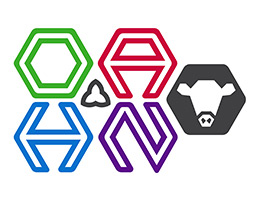Ontario Animal Health Network (OAHN) Bovine Expert Network Quarterly Producer Report
Surveillance Summary
The following data highlights submissions to the provincial veterinary laboratory in Q3 – August to October 2021.
Salmonella Infections
- Salmonellawas detected on 28 lab submissions from an estimated 12 premises.
- Salmonella Dublin was isolated from 21 of the 28 submissions, representing approximately 11 premises (compared to 6-8 detections from 1 or 2 premises in recent quarters).
- The majority of cases were identified in calves ranging from 1 to 4 weeks of age.
- There was one case of Salmonella Dublin in a first-calf heifer (~35 DIM).
Young Calves (< 2 months of age)
35 pathology submissions (dairy n=27, beef n=6)
- Gastrointestinal infections with diarrhea/enteritis or sudden death caused by E.coli or Salmonella
- Cryptosporidiosis, viral enteritis, navel ill, abomasaland/or esophageal ulceration
- Pneumonia due to Mannheimia hemolytica, Streptococcus spp. or Salmonella spp.
- Bacterial arthritis due to Streptococcus spp or E. coli
Older Calves (2 months to 2 years of age)
41 pathology submissions (dairy n=24, beef n=13).
- Necropsy of one dairy calf from a herd experiencing increased post-weaning pneumonia identified pneumonia, arthritis, meningitis and septicemia caused by Salmonella Dublin, and the less common bacteria Gallibacterium anatiswas also isolated. Calves with unresponsive bronchopneumonia associated with drug-resistant Gallibacterium anatis has been reported recently in Belgium.
- Other diagnoses of interest included:
- A 5 mo old beef calf that succumbed to fever and neurologic abnormalities tested positive for Malignant Catarrhal Fever. The calf was housed near sheep who can shed the MCF virus without having the disease.
- One case of Blackleg, a disease typically caused when Clostridium spores are ingested during grazing.
Adult Cattle
37 pathology submissions (dairy n=26, beef n=5, yak n=1, not specified n= 5).
- One bison cow from a group showing clinical signs of malaise and arthritis was diagnosed with Mycoplasma bovis, which is an emerging disease in bison.
- Other diagnoses of interest included:
- Necrotizing mastitis caused by Klebsiella spp.
- Bronchopneumonia caused by Mannheimiahemolytica and Bibersteinia spp
- Hemorrhagic bowel syndrome
- Hardware disease
- Coxofemoral luxation/splay injury
- Fatty liver
Bovine Viral Diarrhea Virus
- A total of 392 tests performed. There were 32 positive results, and these were generally identified as part of routine herd screening.
- One positive result was from an 8-month-old dairy heifer treated multiple times for pneumonia. The animal had extensive lesions on postmortem and is believed to have been a persistently infected animal.
Spotlight on Mycobacterium avium paratuberculosis (MAP)
This quarter, the OAHN bovine network reviewed all MAP testing conducted in Ontario to summarize results over the last year. A testing window of October 1, 2020 to September 30, 2021 was examined and data were provided courtesy of the Animal Health Laboratory and Lactanet.
Animal Health Laboratory
The AHL provides the ELISA test on serum or milk and the PCR and culture test on feces. A total of 3,832 individual tests were performed. The test results are summarized in Table 1.
Where history was provided for ELISA submissions, the test was used for routine herd screening (n=1669), for a new purchase or when requested by a buyer (n=181), as follow-up testing after other positive(s) in a herd (n=435), and as a diagnostic test for animals with clinical signs consistent with Johne’s (n=147).
Where history was provided for PCR submissions, the test was used for routine herd screening (n=171), for a new purchase or when requested by a buyer (n=5), for follow up testing after other positive(s) in a herd (n=12), and as a diagnostic test for animals with clinical signs consistent with Johne’s (n=32).

Lactanet
Lactanet provides the ELISA test on milk. A total of 5,586 tests were performed. The test results are summarized in Table 2.
Generally, as seen in Table 3, percent positive increased with lactation number. Among animals tested, 69% were Holstein animals with a percent positivity rate of 2% and 30% were Jerseys with an 8% percent positivity rate.
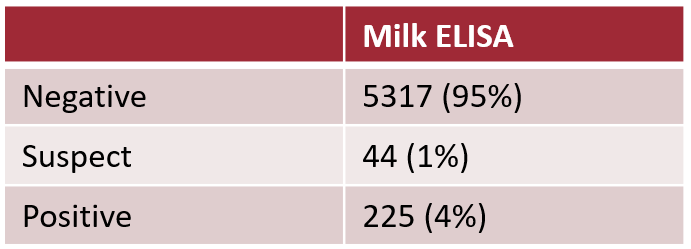
Generally, as seen in Table 3, percent positive increased with lactation number. Among animals tested, 69% were Holstein animals with a percent positivity rate of 2% and 30% were Jerseys with an 8% percent positivity rate.
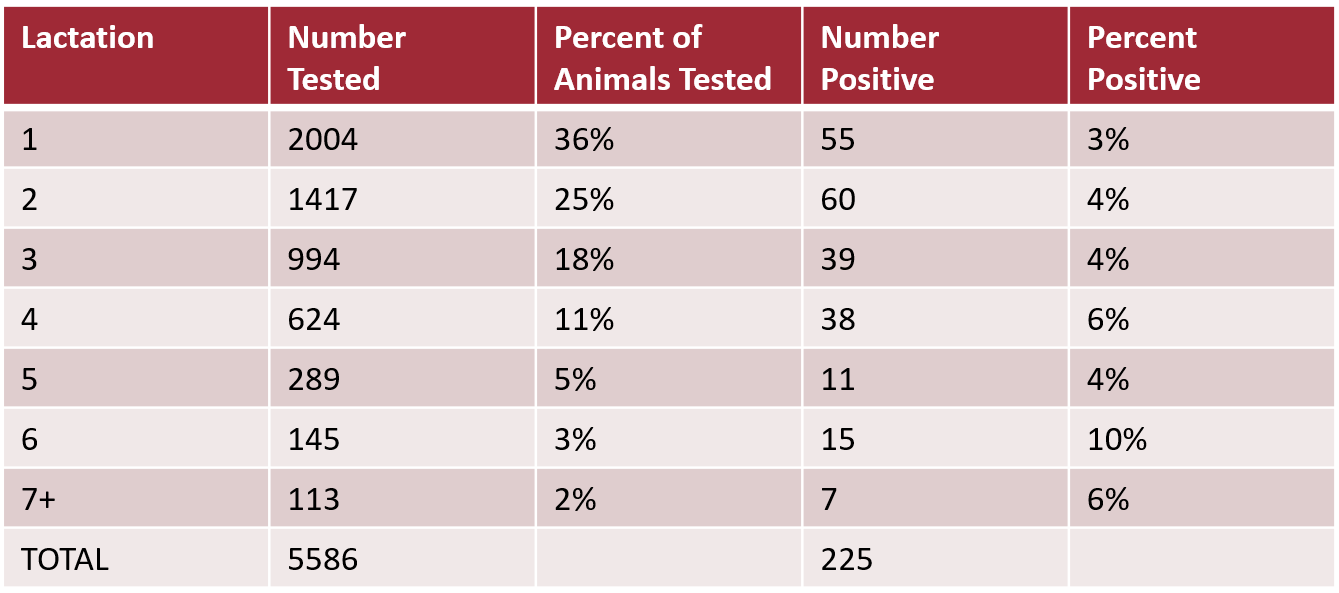
There were 128 herds in Ontario that tested one or more cows during the time period via Lactanet (89 Holstein, 36 Jersey, 1 Guernsey, 2 Mixed). Of these herds, 21 herds tested more than 90% of their cattle. A total of 52 herds tested 50% or more of their animals during the one-year period. 23 of these 52 herds had all negative tests. Among the 29 herds with positive tests, the average positive prevalence was 4% (range 1-32%).
Thank you to Jim Fairles and David Kelton for their time extracting data for this article and to the Animal Health Laboratory and Lactanet for sharing testing results for the benefit of veterinarians and producers.
Herd Profile: Scenic Holsteins is staying the course on disease monitoring
Scenic Holsteins in St. Mary’s Ontario has prioritized disease testing and management in their herd of 250 milking cows. Over the last decade, they have committed to a monitoring program for Mycobacterium avium paratuberculosis (MAP, also called Johne’s Disease) and bovine leukemia virus (BLV).
Herd vet Mac Littlejohn (Kirkton Veterinary Clinic) and Scenic Holsteins’ owner Stefan Weber shared their protocol for testing with OAHN. Stefan collects blood samples from cows during their dry period, taking samples approximately every 2 months for the next set of cows. Serum samples are submitted to the Animal Health Laboratory for ELISA testing.
A recent review of the testing program shows impressive results. All samples tested since 2007 were collated, which includes 1,273 test results for MAP and 2,917 test results for BLV. As demonstrated in Figure 1 and Figure 2, through the efforts of testing and management changes, the prevalence of both diseases has decreased over time.
Over time the herd’s testing strategy has evolved. For MAP, when the prevalence was higher, the farm tested all cows beginning when they entered their second lactation. Recently this has been adjusted to test cows as they enter their 4th lactation or higher. In 2021, this resulted in the herd testing 86 animals, or approximately 34% of the herd. For BLV, all springing heifers and any cow with a previous negative test are tested within 8 weeks of calving.
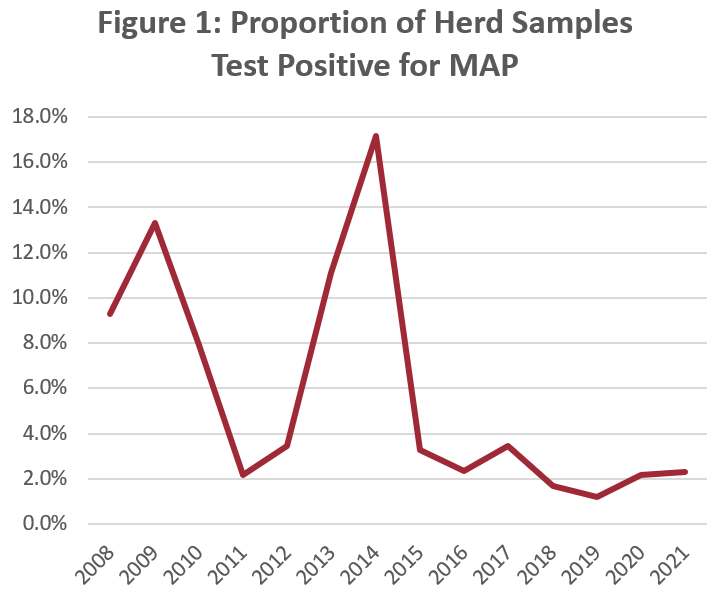
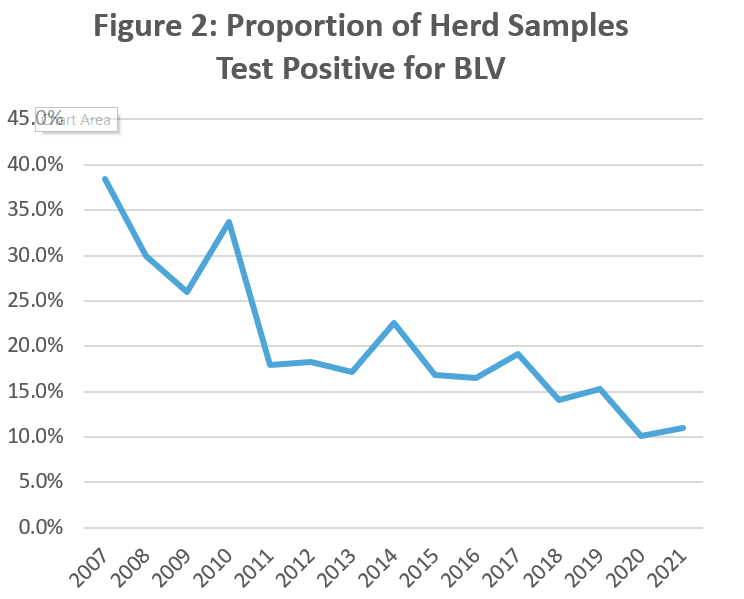
The results from the testing program are used to make management decisions for cows as they calve. Animals with a positive test are immediately labelled in DairyComp. Cows that test positive for MAP calve in a separate area to reduce contamination of the other calving pens. Calving pens are cleaned after any positive MAP cow has calved and these cows are not bred back. The colostrum from known MAP animals is not used for calves and an effort is made to quickly remove these calves from the calving area and provide them with colostrum from a negative cow colostrum bank. Heifer calves from BLV positive cows are also fed negative colostrum.
Other farm management practices are carried out with the goal of reducing the risk of disease transmission in mind. Prior to pregnancy examinations, positive animals are marked with chalk. This allows known positive animals to be examined after all negative status cows. The herd also has a one-time use policy for needles – a new needle is used for each injection on the farm to reduce the risk of transmitting BLV.
Endemic diseases such as MAP and BLV can not be eliminated overnight. Reducing the prevalence in the herd requires a coordinated effort of management changes to reduce transmission and testing to address cattle that are infected or shedding. The diligence and commitment to stay the course is clear from Scenic Holsteins’ results.
The OAHN bovine network gratefully thanks Scenic Holsteins and Dr. Mac Littlejohn for sharing their data and the success of their MAP and BLV control programs.
Exploring Johne’s Testing in Beef Herds
Veterinarians and producers may be interested in the following webinar opportunity through the Beef Cattle Research Centre.
Don’t Roll the Dice with Johne’s Disease – Use our new Johne’s Risk-Reward Calculator
March 16, 2022, 7:00 PM MT
Speaker: Dr. Cheryl Waldner, Western College of Veterinary Medicine
Registration: Webinar Registration – Zoom
